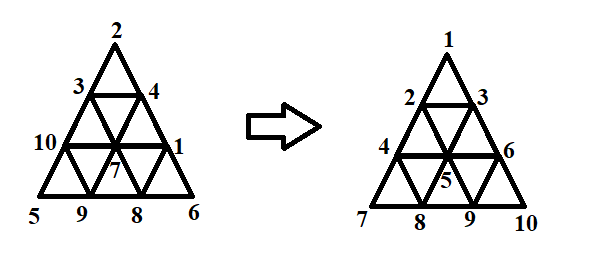
| Online Judge | Online Exercise | Online Teaching | Online Contests | Exercise Author |
|
F.A.Q Hand In Hand Online Acmers |
Best Coder beta VIP | STD Contests DIY | Web-DIY beta |
Triangle Rotation
Time Limit: 4000/2000 MS (Java/Others) Memory Limit: 524288/524288 K (Java/Others)Total Submission(s): 47 Accepted Submission(s): 14
Special Judge
Problem Description
You are given a triangle tower of $n$ layers. There are $i$ vertices in the $i$-th layer, and at each vertex there is an integer written on it.
Below is a figure for $n=4$.

It can be shown that there are a total of $\dfrac{n(n+1)}{2}$ vertices. We guarantee that the numbers are a permutation of all integers in $[1,\dfrac{n(n+1)}{2}]$.
You need to sort the numbers, first by row and second by column, with some numbers of **triangle rotations**. A triangle rotation means:
- Select a unit triangle (the smallest non-zero triangle you can find in the figure) and rotate the numbers on its three vertices **clockwise**.
Determine whether there exists a way to sort the numbers within $2n^3$ operations. If yes, print out one of them.
Below is a figure for $n=4$.

It can be shown that there are a total of $\dfrac{n(n+1)}{2}$ vertices. We guarantee that the numbers are a permutation of all integers in $[1,\dfrac{n(n+1)}{2}]$.
You need to sort the numbers, first by row and second by column, with some numbers of **triangle rotations**. A triangle rotation means:
- Select a unit triangle (the smallest non-zero triangle you can find in the figure) and rotate the numbers on its three vertices **clockwise**.
Determine whether there exists a way to sort the numbers within $2n^3$ operations. If yes, print out one of them.
Input
The first line contains an integer $T(1\leq T \leq 150)$ - the number of test cases.
The first line of each test case contains an integer $n(2\leq n \leq 50)$ - the number of layers of the tower.
The next $n$ lines of each test case represent the numbers in the tower. The $i$-th line contains $i$ numbers.
It is guaranteed that $\sum n^3 \leq 10^6$.
The first line of each test case contains an integer $n(2\leq n \leq 50)$ - the number of layers of the tower.
The next $n$ lines of each test case represent the numbers in the tower. The $i$-th line contains $i$ numbers.
It is guaranteed that $\sum n^3 \leq 10^6$.
Output
For each test case, Output "Yes" or "No" in a single line, indicating whether there exists a way to sort the numbers within $2n^3$ operations.
If your answer is "Yes", Output an integer $k(0\leq k \leq 2n^3)$ - the number of operation you used in a single line.
For the next $k$ lines, output three integers $x,y(1 \leq x \leq n-1,1\leq y \leq 2x-1)$, indicating an operation at the $y$-th triangle between the $x$-th layer and the $x+1$-th layer.
If your answer is "Yes", Output an integer $k(0\leq k \leq 2n^3)$ - the number of operation you used in a single line.
For the next $k$ lines, output three integers $x,y(1 \leq x \leq n-1,1\leq y \leq 2x-1)$, indicating an operation at the $y$-th triangle between the $x$-th layer and the $x+1$-th layer.
Sample Input
3 3 6 4 5 2 1 3 2 2 1 3 2 2 3 1
Sample Output
Yes 11 2 3 1 1 1 1 2 3 2 3 2 2 2 1 2 1 2 2 2 3 2 3 No Yes 2 1 1 1 1
Source
| Home | Top |
Hangzhou Dianzi University Online Judge 3.0 Copyright © 2005-2024 HDU ACM Team. All Rights Reserved. Designer & Developer : Wang Rongtao LinLe GaoJie GanLu Total 0.000000(s) query 1, Server time : 2024-11-22 16:29:17, Gzip enabled |
Administration |